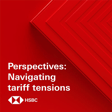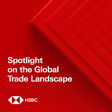Become a Creator today!Start creating today - Share your story with the world!
Start for free
00:00:00
00:00:01

Under the Banyan Tree - Divergence Down Under
Fred Neumann is joined by HSBC’s Chief Economist for Australia, New Zealand and Global Commodities, Paul Bloxham, to discuss divergent policy moves by the RBA and RBNZ, as well as the outlook for commodities and what it implies for Asia. Disclaimer. To stay connected and to access free to view reports and videos from HSBC Global Research click here
Hosted on Acast. See acast.com/privacy for more information.
Transcript
Introduction and Podcast Availability
00:00:00
Speaker
Welcome to HSBC Global Viewpoint, the podcast series that brings together business leaders and industry experts to explore the latest global insights, trends, and opportunities.
00:00:11
Speaker
Make sure you're subscribed to stay up to date with new episodes.
00:00:14
Speaker
Thanks for listening, and now onto today's show.
00:00:16
Speaker
This is a podcast from HSBC Global Research, available on Apple Podcasts and Spotify.
00:00:22
Speaker
Search for HSBC Global Viewpoint or join us via the HSBC Global Banking and Markets page on LinkedIn.
00:00:29
Speaker
However you're listening, analyst notifications, disclosures and disclaimers must be viewed on the link attached to your media player.
Introduction to 'Under the Banyan Tree'
00:00:45
Speaker
Hello everyone and thanks for joining us under the banyan tree where we put Asian economics and markets in context.
00:00:51
Speaker
My name is Fred Newman, Chief Asia Economist here at HSBC and I'm flying solo this week because my co-host Harold van der Linde is still on a very well-deserved break somewhere in Europe.
Central Banks in Australia and New Zealand
00:01:05
Speaker
I'm joined today though by Paul Bloxham, our Chief Economist for Australia and New Zealand, and who also is our Global Chief Economist for Commodities.
00:01:15
Speaker
We'll be talking about both of these areas today, beginning with the recent moves by the Australian and New Zealand central banks and what they tell us about the global monetary cycle.
00:01:26
Speaker
Then in part two, we're going to discuss the outlook for commodities across the board with our customary focus on the Asia-Pacific region.
00:01:34
Speaker
From Hong Kong and Sydney, this is Under the Banyan Tree.
00:01:46
Speaker
Paul, welcome to the podcast.
00:01:47
Speaker
Great to have you.
00:01:49
Speaker
Great to be here, Fred.
00:01:51
Speaker
Paul, so this week we had a lot of fireworks down under when it comes to central bank policy.
00:01:56
Speaker
The RBA surprised the market with a pivot, only 25 basis points.
00:02:02
Speaker
But the RBNZ in New Zealand still delivered a 50 basis point hike.
00:02:06
Speaker
What explains the divergence here between these two central banks?
00:02:10
Speaker
Well, one of the key reasons for that is that there are different inflation dynamics in both of these economies at the moment.
00:02:17
Speaker
Inflation has picked up earlier and has become more embedded in expectations in New Zealand.
00:02:22
Speaker
It's very clearly in the wage setting process.
00:02:26
Speaker
And the RBNZ is very worried about a wage price spiral.
00:02:29
Speaker
So they've remained quite hawkish.
00:02:31
Speaker
But in Australia, although inflation is above target,
00:02:35
Speaker
It's not yet gotten through to the wage setting prices.
00:02:37
Speaker
Wages are only rising gradually across the economy, at least.
00:02:41
Speaker
And a part of that's just the inertia in the enterprise bargaining system down here in Australia.
00:02:46
Speaker
But the lift in wages is a lot more sluggish.
00:02:49
Speaker
And so the RBA doesn't see that same wage price spiral dynamic yet.
00:02:54
Speaker
And as a result of that, they've deemed that they can afford to pivot.
00:02:57
Speaker
There's also a bit of a difference in their reaction functions.
00:02:59
Speaker
The RBNZ has been much more focused on inflation.
00:03:02
Speaker
The RBA has been much clearer that it's trying to find a way to deliver both lower inflation and the soft landing.
00:03:10
Speaker
So how do you think then about the economic outlook for both Australia and New Zealand going into 2023?
00:03:14
Speaker
Well, New Zealand's still got this bigger inflation challenge than Australia has.
00:03:20
Speaker
And so we think that given they're going to have to go harder with interest rates, and they've already done that to a degree, we think that that's going to deliver a harder landing.
00:03:29
Speaker
We've had that in mind for a while.
00:03:31
Speaker
We think New Zealand will likely have a recession around the turn of the year.
00:03:34
Speaker
The unemployment rate will rise.
00:03:36
Speaker
And then we'll be in a world where we'll be thinking about the possibility that the RBNZ might have to start cutting perhaps later next year.
Australia vs New Zealand: Economic Outlook
00:03:44
Speaker
And that's what we've got penciled in.
00:03:45
Speaker
For Australia, we've got a milder story.
00:03:49
Speaker
We haven't got as big an inflation challenge in Australia.
00:03:53
Speaker
The RBA has pivoted already, and we think they've got a couple more hikes in them.
00:03:57
Speaker
But we think that the Australian economy will slow down but not have a recession, that it will be a soft landing.
00:04:03
Speaker
We've got that penciled in for Australia.
00:04:05
Speaker
The other thing that's helping Australia to a degree is
00:04:08
Speaker
is Australia is a large energy exporter.
00:04:10
Speaker
We're the second largest exporter of thermal coal and the second largest exporter of liquefied natural gas in the world.
00:04:16
Speaker
And of course, those products are in high demand at the moment.
00:04:19
Speaker
So that's one thing that I think works in Australia's favour in terms of supporting the growth story a bit more relative to New Zealand.
00:04:26
Speaker
Now, one of the reasons why we pay a lot of attention to the Australian and New Zealand central banks is because they tend to be trendsetter for really the rest of the world.
00:04:36
Speaker
And this week, actually, investors globally paid a lot of attention to particularly the RBA, not moving as aggressively as perhaps some in the market have thought.
00:04:46
Speaker
Do you think there are lessons here for the RBA?
00:04:48
Speaker
for other global central banks from the way the RBA and the RBNZ are setting rates or how they're sounding in terms of their messaging?
00:04:57
Speaker
Certainly, central banks often move in packs, as we know.
00:05:00
Speaker
So I think global investors have been watching these two central banks very carefully.
00:05:03
Speaker
And as you say, they tend to lead the way.
00:05:05
Speaker
The RBA was the first G10 central bank to lift its policy rate after the global financial crisis back in 2009.
00:05:11
Speaker
And the RBNZ was the first
00:05:13
Speaker
central bank this time around to start lifting its policy rate coming out of the pandemic.
00:05:17
Speaker
So they're watching them very carefully.
Impact of Rising Interest Rates on Housing
00:05:20
Speaker
I think that there are two different stories going on, as we've said, for Australia and New Zealand at the moment.
00:05:25
Speaker
In Australia, we don't have that strong pickup in wages growth.
00:05:29
Speaker
But in New Zealand, they've got a wage price spiral challenge.
00:05:32
Speaker
So the main thing I think global investors need to watch is whether whichever country you're looking at, be it the US or Europe or some of the Asian economies,
00:05:41
Speaker
whether those dynamics are more similar to Australia or New Zealand.
00:05:45
Speaker
If you've got a wage pickup, then perhaps the New Zealand story is more applicable.
00:05:49
Speaker
We talk about New Zealand being the Kiwi in the coal mine because it's the country that led the hiking cycle this time around, and we've got a cut penciled in for the tail end of next year, which would be one of the earliest.
00:06:04
Speaker
So it is worth watching these countries for that reason, I think.
Global Commodity Market Trends
00:06:07
Speaker
So really trendsetters here when it comes to the global monetary cycle.
00:06:11
Speaker
But I think global investors are also watching Australia and New Zealand for another reason.
00:06:16
Speaker
That's the housing market.
00:06:17
Speaker
So we've seen big increases in house prices in both economies, I think, over the years.
00:06:23
Speaker
Do rising interest rates pose a risk to the housing markets in Australia and New Zealand?
00:06:28
Speaker
Is that something we should watch?
00:06:30
Speaker
It's definitely worth watching.
00:06:32
Speaker
And we're watching it very carefully as well.
00:06:34
Speaker
It is a risk.
00:06:35
Speaker
But it's also part of the transmission mechanism.
00:06:38
Speaker
The central banks are lifting interest rates.
00:06:39
Speaker
They've lifted them quickly.
00:06:41
Speaker
And getting house prices to fall is one of the ways that they're slowing down the consumer.
00:06:47
Speaker
And it's part of the mechanism for getting inflation to come back down to where it needs to be.
00:06:52
Speaker
In Australia's case, we're a bit less worried.
00:06:55
Speaker
about house prices.
00:06:56
Speaker
House prices didn't go up as much through the pandemic.
00:07:00
Speaker
In New Zealand, we are much more worried about the house price story.
00:07:03
Speaker
House prices went up by about 45%, and even the RBNZ has been worried about them being unsustainable.
00:07:09
Speaker
And they've now fallen by more than a double-digit rate.
00:07:12
Speaker
So we are very carefully watching what's going on with house prices in New Zealand, and also in terms of its sort of financial stability.
00:07:22
Speaker
But for Australia, we're a bit less concerned.
00:07:25
Speaker
Well, it's interesting that you mentioned that really the impact of rising interest rates on the New Zealand economy in particular is worth watching because, of course, New Zealand was earlier in raising interest rates compared to other central banks.
00:07:38
Speaker
So I think there are lessons here for economies elsewhere as well that we should pay attention to.
00:07:44
Speaker
But we'll take a quick break here.
00:07:46
Speaker
And when we come back, we're going to take a closer look at global commodity markets.
00:08:00
Speaker
Welcome back, Paul.
00:08:01
Speaker
We wanted to talk a bit more about commodity markets now.
00:08:05
Speaker
It's an area that you cover as well, being the global chief economist for commodities at HSBC.
00:08:12
Speaker
And first of all, what's happening in global commodity markets?
00:08:15
Speaker
You saw a big pullback in prices in recent months.
00:08:19
Speaker
Is this the beginning of a sharper correction, do you expect?
00:08:23
Speaker
Or is this just that the froth is coming out of some of these prices?
00:08:29
Speaker
We think these commodity prices are still going to stay quite elevated.
00:08:32
Speaker
And the primary reason for that is we think the big driver of the lift in commodity prices has not so much been really strong demand, but it's been constrained supply.
00:08:42
Speaker
We've been describing it as a super squeeze rather than a super cycle.
00:08:48
Speaker
It's not a big demand driven story.
00:08:50
Speaker
It's about less investment in capacity to produce commodities.
00:08:54
Speaker
And it's about
00:08:55
Speaker
geopolitical disruption.
00:08:57
Speaker
So the Russia-Ukraine war disrupting supply of lots of commodities, less investment in recent years in large-scale oil, gas and coal capacity because countries and corporates are trying to meet climate goals.
00:09:10
Speaker
And of course, disruptive weather impact that's had an impact on agricultural supply.
00:09:16
Speaker
All of these things have constrained the supply of commodities and that's tended to push the prices higher.
00:09:21
Speaker
But of course, that means
00:09:23
Speaker
It's a squeeze on global growth.
00:09:25
Speaker
It's not boosting global growth.
00:09:26
Speaker
It's actually slowing global growth.
00:09:28
Speaker
It's another factor contributing to weakening global growth.
00:09:31
Speaker
So the decline in commodity prices we've seen recently, in part, we think, reflects that squeeze, as well as, of course, tighter monetary conditions and the global slowdown that's underway.
00:09:43
Speaker
So we don't think commodity prices are going to fall dramatically or back to below average levels.
00:09:48
Speaker
But obviously, they're coming off a bit on the back of the global slowdown that's underway.
00:09:53
Speaker
So you describe a story of broadly limited supply in many commodity markets.
00:10:00
Speaker
How does Chinese demand play into this?
00:10:03
Speaker
Because we read over the years that China is a huge consumer of things like iron ore, for example, energy, of course.
00:10:11
Speaker
Is the slowdown in China really driving this?
00:10:14
Speaker
And then should that also mean that as China possibly recovers next year, would that then possibly lead to a pickup again in global commodity prices?
00:10:25
Speaker
So this story is quite complicated, but I think it depends on which commodity you're looking at.
00:10:29
Speaker
Because the slowdown we're seeing in China from a commodities perspective, a lot of the story at the moment is about the property recession that's going on.
00:10:37
Speaker
And of course, that tends to weigh more on the bulk commodities like steel, iron ore, coking coal.
00:10:42
Speaker
Those commodity prices have been weaker.
00:10:45
Speaker
Metals prices in general have been somewhat constrained.
00:10:48
Speaker
But then you've also got to keep in mind that there's an infrastructure ramp up that's going on in China.
00:10:53
Speaker
Part of the policy response has been related to infrastructure.
00:10:55
Speaker
A lot of that infrastructure is green infrastructure.
00:10:58
Speaker
And so there's a number of these metals.
00:11:00
Speaker
If we look at the metals that go into the green story, lithium,
00:11:05
Speaker
Cobalt, copper, aluminium, because electric vehicles tend to have more aluminium in them as well.
00:11:11
Speaker
And so there's a balancing item here that's actually providing some support.
00:11:14
Speaker
And as you say, as you run into next year, if China's growth lifts more and it's driven more by the infrastructure story, it should provide some offsetting support for that set of metals.
Agricultural and Energy Prices
00:11:24
Speaker
That said, the property sector, well, the challenges there look as though they're going to be around for quite some time.
00:11:28
Speaker
So the bulk commodities may still be quite suppressed by that overall issue.
00:11:35
Speaker
Globally, of course, there's a lot of investment going on in the green space as well.
00:11:38
Speaker
So that provides a source of demand for those green metals.
00:11:42
Speaker
And I'll still come back to the main theme, which is there hasn't been a whole lot of investment in capacity in recent times to produce those products either.
00:11:51
Speaker
There's an extraordinary amount of investment going on in the moment in lithium, for example.
00:11:55
Speaker
It's not keeping up with demand and prices are very high, but there isn't that much investment in the pipeline for a lot of the other metals that are associated with the green story.
00:12:04
Speaker
So that sort of tells us that it's primarily a supply squeeze that's really been holding those commodity prices up.
00:12:09
Speaker
And that tends not to be great for global growth.
00:12:12
Speaker
So limited supply, certainly for certain metals that you mentioned.
00:12:17
Speaker
But another sector within commodities that has made a lot of headlines is, of course, disruption to the global agricultural trade.
00:12:25
Speaker
And we've seen across Asia, certainly a lot of people being vulnerable to rising food prices.
00:12:31
Speaker
Food inflation has increased.
00:12:33
Speaker
The headlines were very clear for everybody to see.
00:12:37
Speaker
Are you optimistic about a normalization in global food prices going to next year?
00:12:43
Speaker
Or do you think that there are some structural factors at work here, like constrained supply, possibly like in other sectors, that could actually leave us vulnerable to greater volatility going forward?
00:12:56
Speaker
Well, those food prices are certainly something that we have been very focused on.
00:13:00
Speaker
As agricultural prices rose sharply earlier in the year,
00:13:03
Speaker
They've come back down a little bit, but they seem to be stabilising at still quite elevated levels.
00:13:08
Speaker
Now, I think a part of this is going to stick around for a while.
00:13:12
Speaker
A part of it is related to the disruption that came from the Russia-Ukraine war, and that's had a direct impact on the availability of some grains.
00:13:20
Speaker
But it's also having a flow-on effect in the sense that Russia is also the world's largest exporter of fertiliser, and the price of fertiliser went up quite sharply.
00:13:28
Speaker
So a lot of farmers didn't use as much fertiliser through the last season.
00:13:32
Speaker
So it's going to leave a sort of residual continued effect in terms of yields, agricultural yields running into this coming season as well.
00:13:41
Speaker
Overlay that with the fact that, of course, the Russia-Ukraine war is still ongoing.
00:13:45
Speaker
So that creates an uncertainty.
00:13:46
Speaker
We're running into another season, a third season for the first time this century of La Nina, which means that weather conditions may be quite volatile and may be a constraint as well.
00:13:56
Speaker
And it's still the case that there's some residual effects from the COVID-19 pandemic.
00:14:01
Speaker
So there's a lot of moving parts in that story, but I think we should still be very focused on the fact that supply constraints in the agricultural space may continue to leave these agricultural prices at quite elevated levels.
00:14:15
Speaker
So the way you describe that is really limited supply in different types of commodities that will presumably put a floor under commodity prices in this cycle.
00:14:26
Speaker
But you're a student of really long-term commodity trends.
00:14:30
Speaker
So let me ask you...
00:14:32
Speaker
Usually commodity cycles are beholden to the supply side.
00:14:36
Speaker
It is when prices are high, people invest more than prices decline over time.
00:14:40
Speaker
Do you see that supply response coming through?
00:14:44
Speaker
Is that typical cycle at work here?
00:14:46
Speaker
Or are we in an environment where perhaps increased geopolitical risk, rising interest rates are kind of restraining the needed supply response?
00:14:55
Speaker
And then you might say, because of that, we might look at many more years of elevated commodity prices.
00:15:01
Speaker
I think that's part of the story, definitely.
00:15:03
Speaker
Elevated interest rates, geopolitical concerns and so on.
00:15:06
Speaker
But I think the other thing we've got to keep in mind is the energy transition itself is driving this story.
00:15:12
Speaker
And it's almost as though it's what it's supposed to do, right?
00:15:15
Speaker
The underinvestment or less investment in capacity to produce fossil fuels means that, of course, the prices of those fossil fuels are likely to be structurally higher for a period.
00:15:24
Speaker
That will motivate a whole bunch of investment outside of the commodity space in terms of investment in wind capacity, solar capacity.
00:15:31
Speaker
Hydrogen will play an increasing role, but right now it's a very small component of the overall commodities picture.
00:15:37
Speaker
So the energy transition itself is one of those supply constraints.
00:15:42
Speaker
It is forcing investment into other parts away from what we call the larger part of the commodities basket, the fossil fuels.
00:15:51
Speaker
And so there's a whole collection of things suggesting that
00:15:53
Speaker
You know, there is going to be more limited supply that is going to keep the prices higher, but there's not going to be this wide, broad-based resources sector investment upswing like we've seen in previous super cycles, like we saw in the early 2000s.
00:16:07
Speaker
It's different this time around.
Asia-Pacific Energy Dynamics
00:16:09
Speaker
So, Paul, speaking of energy, we still have relatively high energy prices, certainly natural gas, coal price very high, even as crude oil costs have now come down.
00:16:20
Speaker
How does this really the expensive price of fossil fuels, how does it impact, do you think, the Asia-Pacific region?
00:16:29
Speaker
So there are going to be some countries that benefit and others where it's a big drag.
00:16:34
Speaker
I think
00:16:34
Speaker
the big winners, of course, are going to be the energy exporters.
00:16:37
Speaker
So Australia is a big exporter of gas and coal.
00:16:42
Speaker
Indonesia is also another country that's benefiting, I think, from this story in terms of the higher energy costs.
00:16:48
Speaker
In terms of the rest of the region, a lot of them are importers of energy.
00:16:53
Speaker
So that's a weight on growth.
00:16:55
Speaker
But I guess one of the more positive aspects is that a lot of the gas that's imported into Asia is on contract.
00:17:01
Speaker
It's on long-term contracts.
00:17:03
Speaker
It's not on spot prices.
00:17:04
Speaker
So
00:17:05
Speaker
Those long-term contract prices are held down a bit more, and that's at least one of the more positive stories for the region.
00:17:12
Speaker
Well, thanks, Paul.
00:17:13
Speaker
I think reading your research and listening to you, I think it's always interesting how you tease out the importance of structural factors for global commodity markets.
00:17:22
Speaker
So going beyond the headlines and the cyclical factors that are driving prices, perhaps we should keep in mind certainly that these underlying factors are extremely important in driving energy and broader commodity markets indeed.
00:17:37
Speaker
But Paul, here under the Banyan Tree, we have a tradition of asking our guests or indeed our co-hosts certain recommendations, things they've read recently.
00:17:48
Speaker
Is there anything that before we let you go, you might want to recommend our listeners to maybe take a look at?
00:17:55
Speaker
Yeah, there's this great book that I'm reading at the moment.
00:17:56
Speaker
It's called Disorder, Hard Times in the 21st Century.
00:18:00
Speaker
And it's by an academic called Helen Thompson.
00:18:03
Speaker
And it talks about the interaction between
00:18:05
Speaker
the mix of geopolitics and energy and how you've got to think about what's going on in the economic space, not just through the geopolitical lens, but how the energy supply story really plays a bigger role in affecting the economic story too.
00:18:20
Speaker
And at the moment with what's going on in Europe, of course, it's very pertinent.
Conclusion and Future Discussions
00:18:25
Speaker
Well, Paul, thanks for those insights.
00:18:28
Speaker
And we're going to have to wrap things up here.
00:18:31
Speaker
Thank you again for joining us today on The Banyan Tree.
00:18:34
Speaker
Thank you very much.
00:18:36
Speaker
And that's it for another week, folks.
00:18:38
Speaker
Always a pleasure to have you with us here under the banyan tree.
00:18:41
Speaker
We'll be back again next week putting Asian markets and economics in context.
00:18:45
Speaker
Till then, take care and all the best.
00:18:55
Speaker
Thank you for joining us at HSBC Global Viewpoint.
00:18:59
Speaker
We hope you enjoyed the discussion.
00:19:01
Speaker
Make sure you're subscribed to stay up to date with new episodes.
















